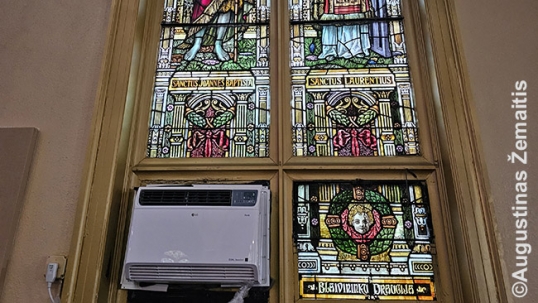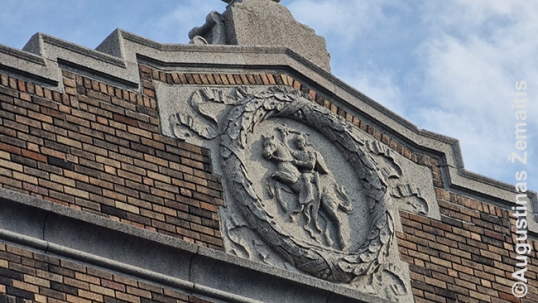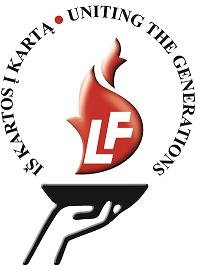Worcester, Massachusetts
Worcester, 64 km westwards from Boston has a population of 180 000, ~2% Lithuanian (~4000). This is the 5th largest number of Lithuanians among all US cities (after Chicago, New York, Los Angeles and Philadelphia).
St. Casimir Lithuanian area
For decades, the massive St. Casimir Lithuanian church (41 Providence Street) was the real hub of Worcester Lithuanian life. It took Lithuanians 13 years to build (1903-1916). It offered regular services from 1916 to 2009, whet it was controversially closed by the diocese. Final mass was held in 2010 for Lithuanian independence day and the building was sold in 2011 to charismatic Christians for 650 000 USD. Altair and other sacred items were removed beforehand, but the St. Casimir‘s bust on the facade remains with the Lithuanian words „St. Casimir, pray for us“. The grand stained glass windows with Lithuanian inscriptions were also fully retained.

St. Casimir church. Its massive size and a hilltop location shows the size of Lithuanian community Worcester once had.

The St. Casimir bust on the St. Casimir church.

St. Casimir church stained-glass window
Interestingly, one of the priests of St. Casimir drowned with Titanic while arriving in the USA. He is said to have acted especially heroically there, giving up his lifeboat seat and helping the dying passengers.
Not far away from the St. Casimir church stands the former St. Casimir Lithuanian school which has a bas-relief of Lithuanian coat of arms and a Lithuanian inscription with its name on its facade, making it one of the most Lithuanian-styled school buildings in America. The school was built in 1924, replacing the wooden "temporary St. Casimir church" that had been used by the parish in 1895-1916. The school had 505 students in 1927, taught by the Lithuanian Sisters of St. Casimir of Chicago. The numbers declined to 199 in the mid-1940s but then increased back to 350 as the Soviet Genocide refugees arrived. As the USA moved to public schooling, the parish school declined and was closed in 1986. The building is now used as a school for children who are unable to learn at regular schools.

Worcester Lithuanian school.

Vytis bas-relief on the school
Lithuanian-named squares of Worcester
Worcester likely has more locations named after Lithuanians than any other US city! That is mostly due to a local tradition to name intersections after World War 2 veterans who gave their life for the USA. With so many Lithuanians living in the area, many of those veterans were Lithuanians. Also, a Lithuanian veteran club worked hard to sponsor these intersection name, most of them located in what was once the Lithuanian district around the St. Casimir church.
There are three Lithuanian-named squares on the Providence St south of St. Casimir: Miglauckas, Kirminas, and Maleskas.
Further on within the once-heavily-Lithuanian-populated area, there are more: Jurgelionis, Kamandulis, Kigas, Banis, Laukaitis, Skerniškis. Krasinskas Square is located in the western outskirts of the city. Every one of them is marked on this map).

Maleskas Sq. sign.

Kirminas Sq. sign.
Our Lady of Vilna Lithuanian area
Worcester was large enough to have a second Lithuanian church, gothic revival Our Lady of Vilna (153 Sterling Street, built ~1925). Today it serves the Vietnamese community indicating that the modern migration to America is mostly non-European, unlike that of the 1900s. Vietnamese-Americans have one thing in common with Lithuanian-Americans however: many of them immigrated after their country has been overrun by a communist invasion.

Our Lady of Vilna church in Worcester. It is the last so-named church in the USA.
Despite the ethnic change, the impressive interior of the church remains staunchly Lithuanian. There are more Lithuanian inscriptions here than in nearly every other Lithuanian-American church (even the saints behind the altar have their Lithuanian names written near their images). Some Lithuanians still pray at the church, although its institutions (school, parish hall) are now mostly used by Vietnamese. Lithuanian visitors are welcome.

Our Lady of Vilna church interior.
Gediminas street still exists in church vicinity (named after Grand Duke Gediminas of Lithuania, 1275-1341, traditionally held to be the founder of Vilnius). In fact, the entire hill the church proudly stands on used to be referred to as Gediminas hill (which is a locality in Vilnius). After all, the church was built in the times of Lithuanian-Polish conflict over Vilnius (1920s-1930s), this likely influencing the prevalence of the Lithuanian language and Vilnius-related symbolism.

Gediminas street sign.
Another testament to that was the memorial for 7 local Lithuanians who died in WW2 in front of the church. Those people died for the USA rather than Lithuania, yet the memorial also had Lithuanian inscriptions and the names of the veterans were written in Lithuanian, with Lithuanian characters and without the changes imposed by the US immigration authorities. However, the memorial was removed ~2022.

Memorial for Lithuanians die din WW2.
Not far away from the Our Lady of Vilnius church is the building of Lithuanian Naturalisation Club, which is adorned by bas-reliefs of both American and Lithuanian coats of arms. Worcester Lithuanians built everything in a way that even after losing their buildings the decor still reminds of the history. While the club itself had been established in 1908, it acquired the current building in 1964 and sold it in 1993.

The former Lithuananian club in Worcester.
Maironis Lithuanian Hall in Shrewsbury
The last remaining operating Lithuanian club of Worcester is Maironis Lithuanian Hall (52 South Quinsigamond Avenue) in Shrewsbury suburb. It is named after the famous Lithuanian patriotic poet of 19th-century national revival. This building rented out for celebrations but it also hosts some 6-8 annual Lithuanian events.
The building has a rather plain exterior as the historic club which stood here burned down in 1973. The interior of its 1974 replacement, is, however, rather grand, as it includes Lithuanian paintings on its walls at the basement floor. These were painted by a Lithuanian-American Rūkštelė who lived within the premises while he worked. The first floor hall, on the other hand, is mostly used for rentals and is thus devoid of Lithuanian symbolism. This Hall used to be known as "Maironis Park" but had its name changed ~2022 to avoid misconception that it is a park rather than a building. Nevertheless, Maironis does indeed include extensive grounds for car parking, as well as a lakeshore, making Maironis convenient for outdoor Lithuanian celebrations such as the midsummer Joninės. This land together with a residential home was acquired by Lithuanians in 1923 and Maironis Park was opened in 1924. That original building was expanded multiple times by adding new halls in 1962 and 1968 and was undergoing yet another expansion at the 1973 moment it burned down.

Lithuanian scenes at one of Rūkštelė paintings (depicting, left-to-right, the Vilnius Cathedral, Kaunas city, and the grave of unknown soldier in Kaunas)
Next to Maironis stands a Memorial for those who died for free Lithuania adorned in patriotic symbols (Columns of Gediminas, Vytis (the coat of arms), two Crosses of Vytis). Built in 1978, this memorial initially stood at the St. Casimir church. However, it was relocated after the church was sold in fear that the new owners would have destroyed it otherwise.

Memorial for those who died for Lithuanian freedom at Maironis park.
Historically, the eastern shore of Lake Quinsigamond hosted numerous additional Lithuanian clubs, often named "Parks". This included a Lithuanian Veteran club, Lithuanian leftist club (Olympia Park), Vytautas Park, and more. All of these clubs closed since, however, and the Lithuanian activities slowly retreated to Maironis, with the historic other club buildings either demolished or no longer visibly Lithuanian. After the closure of their own buildings, various clubs continued operation in Maironis premises.
In 2010 the Worcester municipality recognized its partly Lithuanian roots by twinning with a town of Ukmergė in Lithuania.
>The map
All the Lithuanian locations, described in this article, are marked on this interactive map, made by the "Destination - America" expedition (click the link):






November 4th, 2017 - 13:56
It was great city to grow up in. My past is full of wonderful memories of St Casimir’s Church and school and the nuns that tried to keep us on the right path (without success I might add). Even now Maironis Park is known throughout the United States as one of the iconic centers of Lithuanian culture.
December 3rd, 2017 - 04:05
Does anyone remember Olympia Park. It was a great Lithuaniangathering place in the summer. People from all over the country used to come on busses. I loved it there.
July 27th, 2020 - 19:30
Does anyone know Frank Bobblis or Magdalena Baukas Bakiute? They were my godparents when I was baptized at Our Lady of Vilna church in 1929. I am trying to learn more about my ancestors.
December 3rd, 2017 - 04:08
My mom and aunt and uncle sang in the Lithuanian Chorus. Helen Smith. Irene Janulis and Richard Janulis and nsna Helen Zelinskas?
December 26th, 2017 - 22:07
My cousin was friends with your Mom when they lived on Suffield st.
December 26th, 2017 - 22:09
I remember Olympia PARK AMD THE MANY,MANY STEPS DOWN TO THE LAKE
March 26th, 2019 - 02:19
( I remember those stairs at Olympia Park. I got married to Jack Kasper at Our Lady ofVilna. Lived on Vernon Hill. Wonderful memories! AND I lived on Suffield St in the thirties……..Aldona Pauliukaitis Kasper
May 1st, 2023 - 10:59
I think i remember your family. we lived on Harrison st virner of Waverly
May 1st, 2023 - 11:16
I think i remember your family. we lived on Harrison St., corner of Waverly. My grandparents , Cyprian & Vincenta , had a small grocery store. I lived there until I was 15 years old. That highway decimated my family & the Lithuanian community.
Aldona. … do i remember you or would it have been another family member with your name? I remember a beautiful smile on a stately regal strawberry blond who walked home passing ours. She may have known my Aunt Anne.
I truly treasure my life , close to St Casmir’s, up the hill from the Broadway and the magic of Water St. our home abutted the Tifereth Israel Synagogue: they were wonderful neighbors!
jan zinkevich girouard
May 1st, 2023 - 11:20
Altona. … do I remember you or would it have been another family member with your name? I remember a beautiful smile on a stately regal strawberry blond who walked home passing ours. She may have known my Aunt Anne.
I truly treasure my life , close to St Casmir’s, up the hill from the Broadway and the magic of Water St. Our home abutted the Tifereth Israel Synagogue: they were wonderful neighbors!
jan zinkevich girouard
July 3rd, 2019 - 00:30
The St Casimir Parish and school was a bedrock of my formation. The good sisters, our spiritual leaders instilled within us a love of country, respect for our community and a reminder of our heritage. I credit this foundation with the success I found in earning some wonderful opportunities for my future beyond St Casimir, including my appointment to the US Naval Academy and appreciation for education that took me through multiple advanced degrees. I left Worc many years ago, but the memory of St Casimir will draw me there in spirit always.
July 30th, 2019 - 18:32
Good friends: I am a granddaughter of Lithuanian immigrants who settled in Shrewsbury not too far from the Lithuanian Club. I remember walking there with my grandfather who sat my sister and I down on the steps with orange crush while he went inside – we were lucky recipients of many half dollars and quarters as the patrons went in and out! Do any of you with Shrewsbury roots recall the Zulkus family on Cedar Road?
May 28th, 2020 - 23:31
Does anyone know if Jasiukonis or anything close to the surname has gone to this church? I am searching for my ancestors. Thank you. Sharon
June 4th, 2020 - 10:48
Maybe you should try to get the church records of marriage, baptisms and funerals.
May 7th, 2021 - 20:39
Try Our Lady of Czestochowa.
I recognize the name, someone I know as Jasukonis.
They lived off Greenwood Street in Worcester
December 31st, 2022 - 21:36
My Grandparents (Akstinas and Smolsky) were married by a Father Jasiukonis in the 1920’s at St.Casimirs.
August 31st, 2020 - 01:26
Any St. Casimier folk remember the Jeswcik (Jeskis) name (Walter, Martha, John, Peter, Rose) circa 1940s.
March 1st, 2023 - 01:10
I have many fond memories of St. Casimir church and school. I wa president of the altar servers in 1961: I played four years on the church team.
March 1st, 2023 - 01:23
I have many fond memories of St. Casimir church and school. I wa president of the altar servers in 1961: I played four years on the church basketball team. I still own a basketball shirt from 1965: God bless St. Casimir’s!
November 18th, 2020 - 23:07
My Grand father and grandmother were married in St. Casimirs church in Worcester Mass. on January 25, 1902 according to their marriage certificate.
February 13th, 2021 - 11:25
My Grandmother Mary Galanaitis was a long time member of Our Lady of Vilma until she purchased a three decker at 507 Cambridge Street in South Worcester. It was directly across from Cambridge Street Grammar School. We would walk together to St. John’s Cemetery and visit my Grandfather Joseph memorial. I went to Cambridge Street Grammar, then Providence Street Junior High and South High School. When I went off to Lowell Technological Institute for my college education, my Worcester years became fewer and fewer. After my stint in the U.S. Army, I became a Mid-Caper & have my proud memories of my South Worcester heritage.
April 13th, 2021 - 18:51
The maternal side of our family is names Senkavitch. My mother was Emily. The rest of her family was Mother Anna, Father William and siblings Joseph, William, George, Mary and Lillian. As a child we attended 8:30 Mass at St. Casimir’s and Sunday school afterwards. We were saddened when our church was closed. I attended the closing ceremony as everyone sang Marija, Marija at the main door as it was closed. Those of us who are left now still reminisce about the happy times of the holidays and outings at the area Lithuanian social clubs. Made Kugelis for Easter this year.
November 7th, 2021 - 08:41
Hi, I am researching my family tree and trying to see how two families are related. My father Vytautas (Veto) Gailiunas went to church at St. Casimir’s. His parents were Jonas and Frances Gailiunas. I want to find out how they were related to Anna and Bruno Saviskas (Savickas). They all went to Maironis Park (in fact I used to go when I visited as a child). Can anyone help me?
April 19th, 2022 - 14:15
I remember Veto Gailiunas very well . He was part of our young group of Lithuanian friends . He was always very polite and affable . It was so long ago but it seems like yesterday remembering him and his sister at Maironis park . He belonged to the Lithuanian Boy Scouts in Exile . By sheer coincidence my daughter’s professor at UCONN Dental school was a friend of Veto and liked him very much .
January 17th, 2022 - 20:21
I am looking for a baker named Nemkines (possibly wrong spelling) and his wife Anna Kraunelis for family research (probably early to middle 1900s) They were in the Worcester area. Any information greatly appreciated.
February 14th, 2022 - 00:41
Does anyone remember the Buchyn’s
March 13th, 2022 - 13:15
My grandfather, Gabriel Shilalie, was proud of his being among those who helped to build Our Lady of Vilna Church.
October 16th, 2022 - 23:59
I have a very old scrapbook that I saved from St Ann Church when it was demolished about 1969 that has all newspaper articles about Lithuania. Early 1900’s. St Casimirs mentioned throughout. Very fragile. I would like to show it or give it to Worc Lithuania historians. I think very interesting reading. .
November 16th, 2022 - 02:19
You may contact Maironis Park, they may be interested, or you may contact the ALKA archives in Putnam, Connecticut
May 1st, 2023 - 14:08
can you please ad the contact info for ALKA. Putnam, CN
June 29th, 2023 - 03:31
You should contact Mirga Girniuvienė / Mirga Girnius of Westford, MA